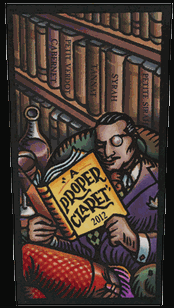Bonny Doon Vineyard, California “A Proper Claret” 2012 ($16): In the wacky world of wine that proprietor Randall Grahm has fashioned at Bonny Doon Vineyard, Cabernet Sauvignon has been persona non grata for the past 28 years, while red Rhône and South-of-France varieties such as Syrah, Grenache, Mourvedre, Cinsault and Carignan hold court along with Nebbiolo and other Italian grapes, Zinfandel, Pinot Noir, and an assortment of mainly counter-culture white grapes. It might come as a bit of a surprise, then, to hear that Bonny Doon Vineyard has released a  Cabernet-dominant blend. And not only a Cabernet blend, but one that invokes the very traditional, very British name for a red Bordeaux wine, “claret.”
Cabernet-dominant blend. And not only a Cabernet blend, but one that invokes the very traditional, very British name for a red Bordeaux wine, “claret.”
This wine is named “A Proper Claret,” and of course it isn’t — because every Bonny Doon label has an element of tongue-in-cheek. In fact, it is very different from the medium-weight, very structured, fruit-shy, lean and ageworthy red wines that the Bordeaux region produced back in the days when Bordeaux was called claret. But today’s wine drinkers who are accustomed to the ripe fruitiness and rich flavor expression of wines from Rhône varieties — and wines made in the modern richness-power model, for that matter — can probably find something claret-like in the wine’s style.
The wine derives largely from native Bordeaux grape varieties, if not today’s normal Merlot-Cabernet Sauvignon-Cabernet Franc trio. Together with 62 percent Cabernet Sauvignon, it has 22 percent Petit Verdot, a bit player in Bordeaux that has begun to make a few truly interesting wines elsewhere. Next is 8 percent Tannat, a French variety from southeast of the Bordeaux region yet in my mind consistent with a claret theme. But the 7 percent Syrah and the 1 percent Petite Sirah — these are outliers, distinctly not “proper.”
As its tech sheet describes, the wine is neither overly alcoholic (13 percent) nor overly extracted, and these elements of restraint are part of the wine’s claret-like demeanor. The aromas and flavors of small, dark berries, cedar and spice and the wine’s slightly grippy tannins and firmness are also claret-consistent. But the fruitiness is pure California, and the wine is all the better for that. Fresh, juicy, delicious fruity texture and flavor surround the wine’s lean and firm structure and bring an exuberance to the wine that no proper claret could have.
(Comparisons to claret aside, this wine is a dry, moderately fruity red with a lovely balance of structure to fruit; depth and length on the palate that confirm quality; flavor that captivates; and restraint enough to keep the wine enjoyable glass after glass.)
To make a Cabernet with moderate alcohol and no trace of under-ripe, herbaceous notes is no small feat. Randall Grahm explained that by fermenting the Cab at a fairly high temperature and later incorporating microbullage (tiny oxygen bubbles) in the wine he was able to avoid herbaceousness. But the Cabernet grapes themselves had little potential for herbaceousness; they were very uniform in ripeness, with small clusters of small berries grown on vines that were, unusually, “box-pruned” to resemble a hedge. Another winemaking particular is that some of the Syrah grapes were air-dried to bring a spicy savory character to the wine.
Ironically for a winery in the “Anything But Cabernet” camp, Bonny Doon Vineyard will release “A Proper Claret” again in the 2013 vintage, and plans to make the wine indefinitely thereafter.
On my table, I enjoy this wine in a rather lean glass, which restrains the fruitiness — but that’s me. For food pairings, my mind anticipates the end of this month and thinks: turkey.
90 Points
